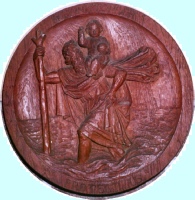

Introduction
There is very little recorded about either of the two ships bearing the name HMS St Christopher and so what follows is inevitably a compilation of a variety of sources. However, the impact that the second HMS St Christopher, a coastal forces training base had, and indeed still has, on Fort William cannot be ignored. It is therefore with this in mind that this information has been collated.
While this web page summarises what we have been able to find out about HMS St Christopher, there is undoubtedly much more that yet to be revealed and so if you have any further information I would be delighted if you could contact me at the address given at the end of this piece.
Piratical beginnings in the Caribbean!!
Very little is known of the first HMS St. CHRISTOPHER, but it seems that she was originally the MOWHAWK, a 279 ton French privateer which was armed with six eighteen pounder carronades and two long six pounders. The ship was given to the Royal Navy by the people of the Island of St Christopher (St Kitts) in the West Indies and was commissioned in March 1806. The Caribbean was a popular posting at the time of Nelson’s Navy as any pirate or privateer ships which were captured became the spoils of the capturing ships crew. Indeed, the contents of a heavily laden pirate ship could allow a Royal Naval ship’s company to retire in comfort. Hence in an entry from O'Byrne, from the biography of John Tancock we read:
"...made Commander, 15 Aug. 1806, into the ST. CHRISTOPHER sloop....During his servitude in the ST. CHRISTOPHER Capt. Tancock made prize, on the West India station, of several small Spanish vessels, detained a Danish ship which was condemned as a droit of Admiralty, and re-took a British merchantman, laden with bale-goods, from Glasgow bound to St. Thomas'. He was also, 25 Dec. 1807, present at the surrender of the Danish island of Ste. Croix to the military and naval forces under General Bowyer and Sir Alex. Cochrane."
It also appears that in January 1807 the French Privateer Entrepenante was captured by Commander Andrew Hodge and his crew. There seems to be a conflict in the information here but it could be that Commander Hodge was only in temporary command.
The next record we find is from 25th May 1808 when HMS ST CHRISTOPHER took part in the rescue of the shipwrecked crew of HMS ASTREA at the southern end of the Caribbean island of Anegada.
A later record of HMS St CHRISTOPHER comes from 1809 when she was commanded by Commander Henry Rowe. The information comes from Henry Nathaniel Rowe's entry in O'Byrne:
"In 1809 he was sent in the ROSAMOND sloop, Capt. Benj. Caldwell, to the West Indies, where, on 19 Dec. in the same year, he was nominated by Sir Alex. Cochrane Acting-Commander of the ST. CHRISTOPHER sloop. To that vessel, after he had assisted at the reduction of Guadeloupe, he was confirmed by commission dated 2 May, 1810."
The ST CHRISTOPHER’S last Captain seems to have been Commander William McCulloch in 1811 when, on 18th August of that year the first HMS St Christopher was ordered to be broken up in Antigua.
Perhaps, somewhat less than coincidentally, the neighbouring island is called Nevis which may have been named after the mountain above Fort William. Whether this had a bearing on the Admiralty giving the WWII training base its name is, at this stage only conjecture!
